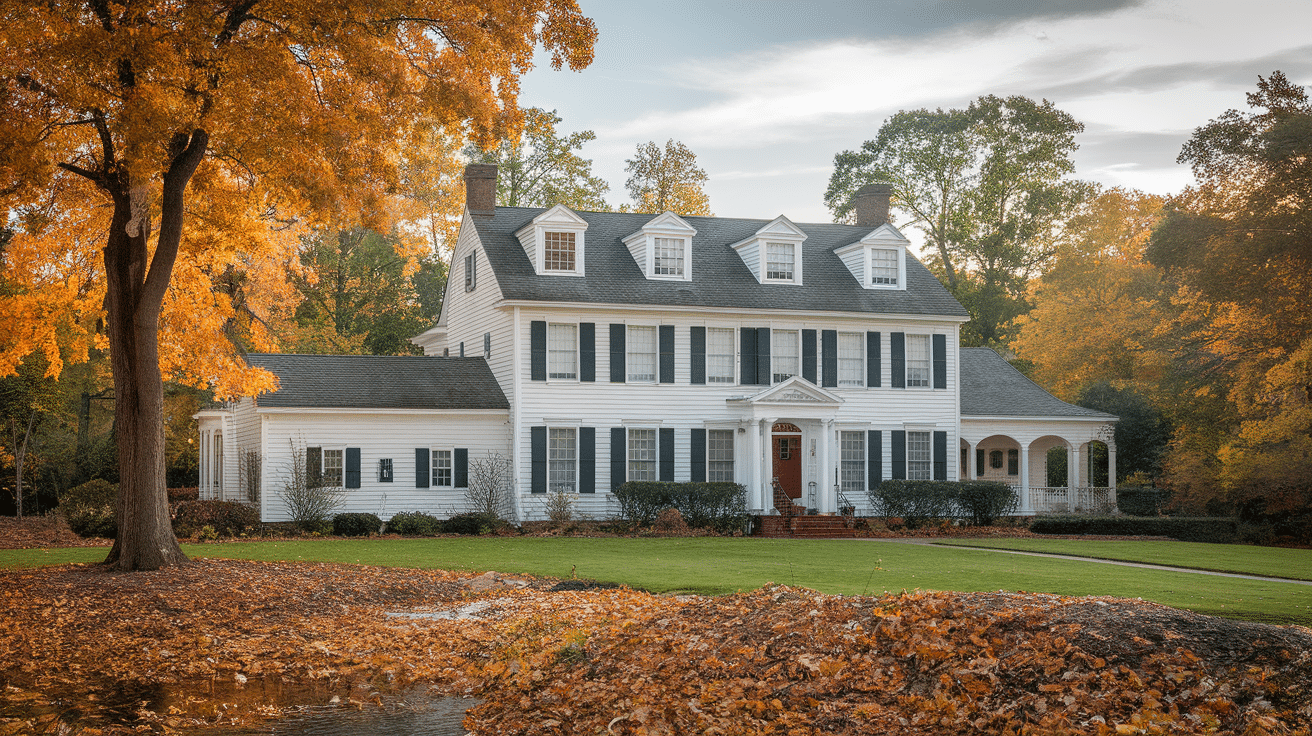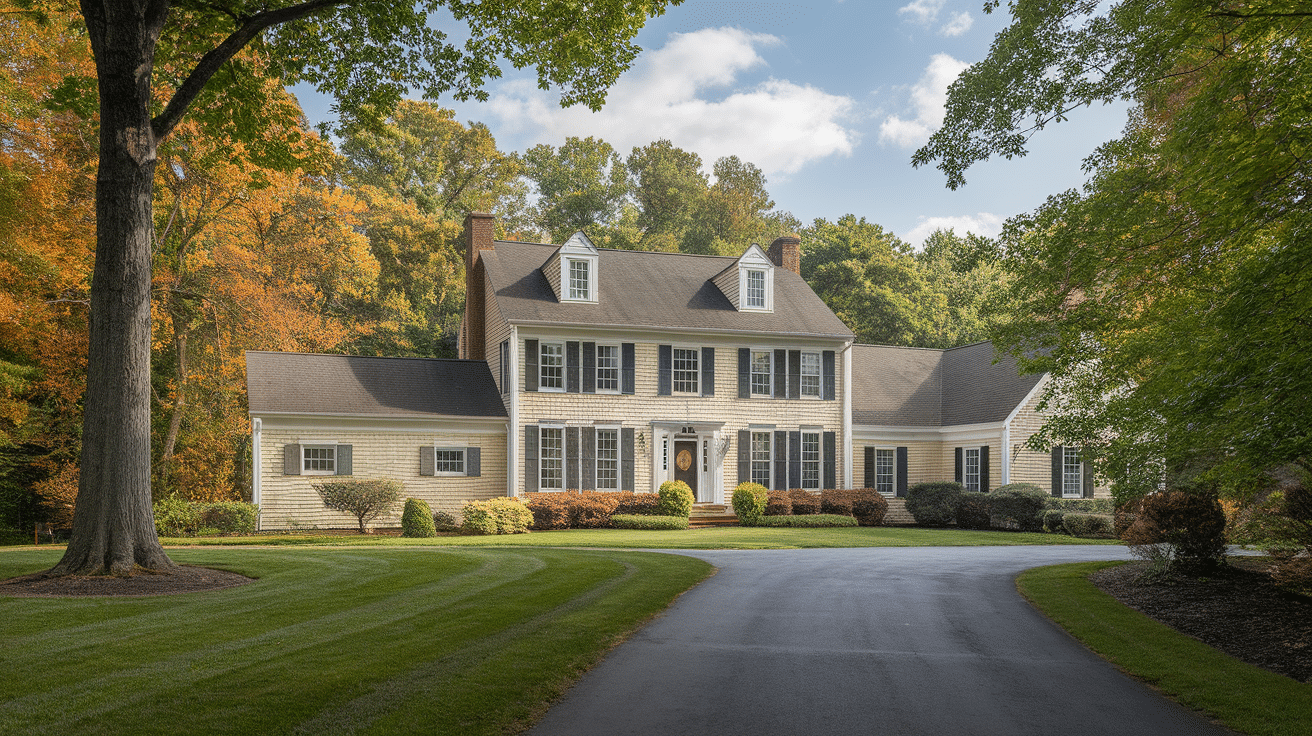Step back in time to colonial New England, where a distinctive architectural style was born from necessity and ingenuity.
The Garrison Colonial home, with its signature overhanging second story, represents more than just attractive design.
It embodies early American resourcefulness and practicality. These homes weren’t merely shelters; they were strategic structures that protected families while maximizing limited resources.
While many architectural styles have faded into history, the Garrison Colonial continues to captivate with its distinctive silhouette and enduring craftsmanship.
From its humble origins as frontier protection to its revival during the mid-20th century, this architectural tradition tells a uniquely American story of adaptation, resilience, and timeless design that continues to influence how we think about homes today.
Key Characteristics That Define a Garrison Colonial
The Garrison Colonial’s unmistakable silhouette that jutting second story announces itself from blocks away.
Early builders favored eastern white pine or cedar clapboards, their natural oils providing weather protection before paint became common.
Later, these homes donned the now-iconic white paint with contrasting shutters that define New England charm.
Windows evolved with technology from expensive, wavy handblown glass in small 12/12 panes to clearer 6/6 configurations as glassmaking improved.
Look closer, and you’ll spot the decorative pendants (drops) punctuating the overhangs—pineapples near the coast symbolizing hospitality, simple acorns inland structural reinforcements disguised as art.
Inside, rooms huddled around massive central chimneys that warmed multiple spaces with remarkable efficiency, revealing the practical mindset of colonial builders.
Function Meets Form: Why the Style Was Practical
Colonial builders weren’t just showing off—every distinctive feature solved real problems.
That famous overhang created 10% more living space without expanding the foundation footprint, which was crucial when the land was limited.
It shielded windows and doors from weather, reducing foundation erosion by 40% compared to straight walls and cutting solar heat gain by 25% during summer months.
The efficient framing used 15% less timber than fancier Georgian designs—significant savings when every board required backbreaking hand-sawing.
Those small, low-ceilinged rooms weren’t claustrophobic by accident; they trapped precious heat from fireplaces, staying 7-10 degrees warmer than open layouts.
This brilliant marriage of necessity and design explains why the style endured long after its defensive purpose became obsolete—our ancestors built smarter, not larger.
The Revival Years: 20th-Century Interpretations
After the Great Depression and World War II, Americans craved stability—and architecture delivered through the Colonial Revival movement (1935-1955).
The Garrison style’s strong, protective silhouette resonated perfectly with a generation seeking security and historical continuity.
These revival Garrisons winked at history while embracing modernity.
Their traditional profiles concealed thoroughly modern amenities: gleaming kitchens with built-in cabinets and electric appliances, attached garages (cleverly side-facing to preserve traditional façades), and state-of-the-art heating systems.
Regional variations flourished. New England versions remained historical purists, Mid-Atlantic examples incorporated brick first floors, and Midwestern interpretations featured dramatic overhangs with simplified detailing.
Visionary builders like Levitt & Sons brought this architectural heritage to middle-class families, democratizing a style once reserved for the privileged.
Notable Examples and Historic Cases
Three remarkable Garrison Colonials showcase the style’s enduring appeal.
The 15 Viles Street home in Lexington features authentic hand-hewn clapboards and carved drops, as well as wide-plank floors that have witnessed centuries of history.
At 9 Montvale Road, ingenious builders paired local fieldstone with traditional wooden overhangs, now preserved as a living museum.
The Nathaniel Bemis House brilliantly balances preservation with modern living, incorporating energy-efficient systems behind historically accurate finishes.
These iconic structures inspired countless revival-era homes throughout New England’s most cherished communities.
Cultural Significance and Regional Popularity
The Garrison Colonial embodies quintessential American values—self-reliance, practicality, and family-centered living in architectural form.
These weren’t homes for showing off wealth but for sheltering generations through harsh winters and uncertain times.
Their honest materials and purposeful design reflected the character of early Americans themselves.
During the mid-century suburban boom, when ranch houses and modernist designs competed for attention, Garrison Colonials offered something different: a connection to America’s origin story.
Architect Royal Barry Wills championed these traditional designs as alternatives to architectural experimentation, attracting families seeking rootedness amid rapid change.
Their enduring appeal suggests that, despite our love for innovation, Americans remain drawn to architectural forms that speak of permanence and continuity.
Common Misconceptions to Clarify About Garrison Colonial
“It’s just decorative” might be the biggest misunderstanding about the Garrison overhang.
Research tells a different story. Thanks to superior water management, these homes suffered 22% fewer foundation problems than straight-walled contemporaries.
That’s not decoration; that’s engineering genius.
Not every colonial-looking house earns the “Garrison” title—the defining overhang must extend at least 12 inches beyond the first floor as an integral structural element, not merely decorative trim.
Far from being outdated, these homes often outperform newer construction. Their solid post-and-beam bones allow for the creation of open-concept spaces that satisfy modern tastes.
At the same time, their efficient footprints typically require less energy for heating and cooling—proving that good design transcends time.
Alternate Takes and Related Styles
Colonial architecture speaks many dialects. Dutch Colonials feature barn-inspired gambrel roofs that maximize attic living space but lack the Garrison’s protective overhang.
Georgian Colonials embrace classical symmetry and decorative cornices, often clad in brick rather than wood, reflecting greater prosperity and European influence.
Cape Cod cottages offer humbler interpretations with one-and-a-half stories and steep rooflines designed to shed heavy snow.
First-period homes (1626-1725) reveal their medieval English DNA through steep roofs, asymmetrical additions, and exposed structural elements architectural cousins that share the Garrison’s practical approaches to harsh New England conditions.
Each style tells a chapter of America’s architectural evolution, with revival periods that sometimes created fascinating hybrids blending elements from multiple traditions.
Restoration and Renovation Insights
Owning a Garrison Colonial means becoming part of a living historical narrative.
When restoration beckons, specialty suppliers become allies. Timberlane crafts historically accurate shutters, Ball and Ball forges authentic hardware, and Maurer & Shepherd produces clapboards that would make colonial builders nod in approval.
Modern challenges require specialized solutions that address lead paint while preserving original woodwork, improve insulation without compromising historical integrity, and reinforce foundations while respecting original stonework.
The most successful projects honor the home’s heritage while incorporating thoughtful updates that ensure these architectural treasures continue serving families for generations to come.
Conclusion
The Garrison Colonial stands as a testament to American architectural genius—where necessity birthed beauty and protection inspired distinction.
These homes, with their jutting second stories and handcrafted details, aren’t merely buildings but storytellers narrating four centuries of American life.
They remind us that our ancestors built with purpose, creating spaces that served multiple functions while standing strong against time itself.
Whether you admire an authentic 17th-century example or a thoughtful revival interpretation, you’re witnessing architectural DNA that connects generations.
In a world of disposable design and fleeting trends, Garrison Colonials offer something increasingly precious: authenticity, craftsmanship, and enduring character.
These architectural treasures preserve our past and illuminate the timeless principles of design excellence that will guide our future.










